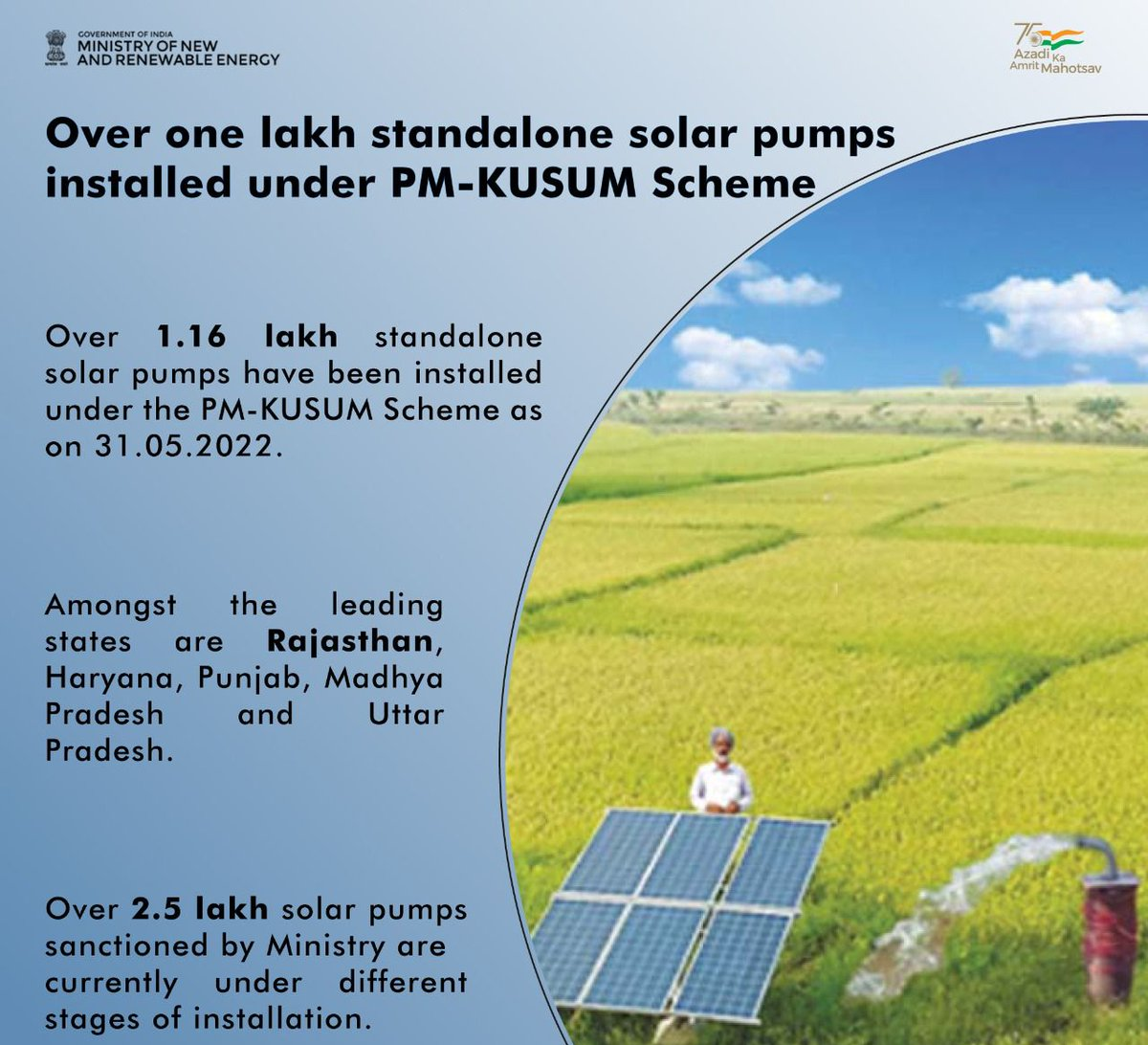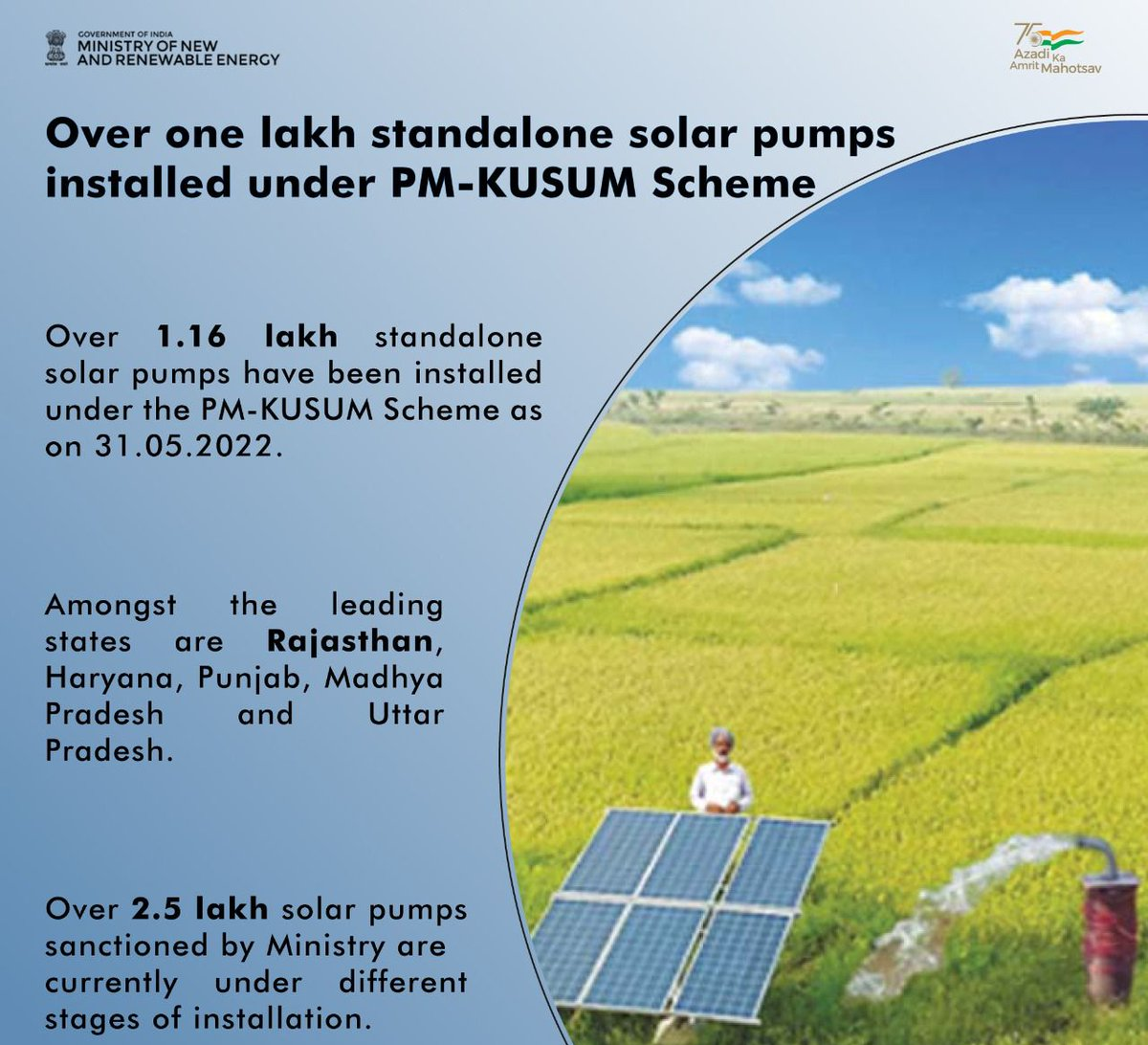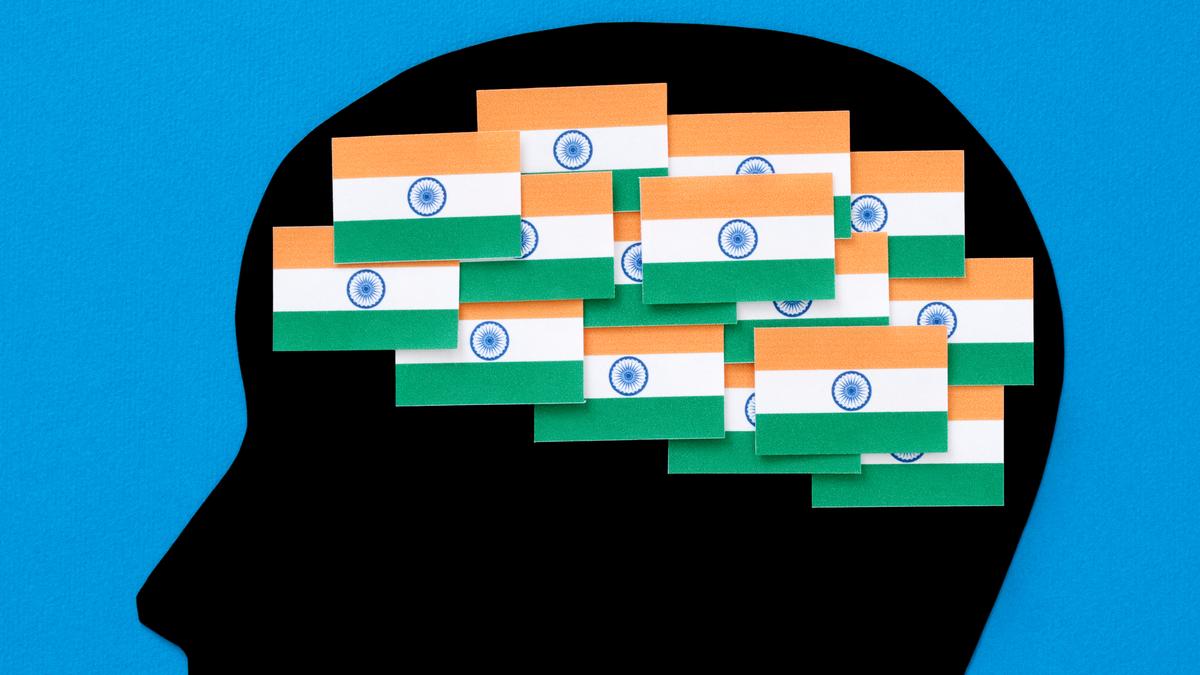- Courses
- GS Full Course 1 Year
- GS Full Course 2 Year
- GS Full Course 3 Year
- GS Full Course Till Selection
- Answer Alpha: Mains 2025 Mentorship
- MEP (Mains Enrichment Programme) Data, Facts
- Essay Target – 150+ Marks
- Online Program
- GS Recorded Course
- Polity
- Geography
- Economy
- Ancient, Medieval and Art & Culture AMAC
- Modern India, Post Independence & World History
- Environment
- Governance
- Science & Technology
- International Relations and Internal Security
- Disaster Management
- Ethics
- NCERT Current Affairs
- Indian Society and Social Issue
- NCERT- Science and Technology
- NCERT - Geography
- NCERT - Ancient History
- NCERT- World History
- NCERT Modern History
- CSAT
- 5 LAYERED ARJUNA Mentorship
- Public Administration Optional
- ABOUT US
- OUR TOPPERS
- TEST SERIES
- FREE STUDY MATERIAL
- VIDEOS
- CONTACT US
PM KUSUM
PM KUSUM

Why in News?
Recently, the Ministry of New and Renewable Energy (MNRE) has extended the deadline to install 30,000 MW solar power capacity in rural India to March 2026 under PM-KUSUM (Pradhan Mantri Kisan Urja Suraksha Evam Uttham Mahabhiyan).
About Solar Energy
1. Solar energy is any type of energy generated by the sun.
2. Solar energy is created by nuclear fusion that takes place inside the sun.
3. Fusion occurs when protons of hydrogen atoms violently collide in the sun’s core and fuse to create a helium atom.
About the Overall Status of Solar Energy in India
1. As of December 2022, 61GW of solar power has been installed so far in India.
2. Earlier, India has set an ambitious target to achieve a capacity of 175 GW worth of renewable energy by the end of 2022 (in which 100 GW was to be solar power), which expands to 500 GW by 2030. This is world’s largest expansion plan for renewable energy.
3. India is the 2nd largest market in Asia for new solar PV cells and 3rd globally. It ranked 4th for total installations (60.4 GW), overtaking Germany (59.2 GW) for the first time.
4. As of November 2022, Rajasthan and Gujarat were the top states for large-scale solar energy generation, accounting for 53% and 14% of installations, respectively, followed by Maharashtra with 9%.
What is PM KUSUM?
1. The PM-KUSUM was launched by the MNRE in 2019, to promote the installation of off-grid solar pumps in rural areas and to reduce dependence on grid.
2. Components of the Scheme are:
A) 10,000 MW of decentralized ground-mounted grid-connected renewable power plants,
B) Installation of 20 lakh solar-powered agriculture pumps,
C) Converting 15 lakh agriculture pumps, that are already connected to the grid into solar.
3. Objectives of the Scheme are:
A) It aims to enable farmers to set up solar power generation capacity on their arid lands and to sell it to the grid.
B) It also seeks to increase the income of farmers by allowing them to sell surplus solar power to the grid.
Achievements of the Scheme are:

About the Significance of the Scheme
1. It incentivizes the farmers to sell surplus solar energy to the states, which in turn will increase their income.
2. The scheme is expected to increase access to electricity in rural areas and provide a reliable source of energy for agriculture and other rural activities.
3. If farmers are able to sell surplus power, they will be incentivized to save power and, in turn, it will mean the reasonable and efficient use of groundwater.
4. Expansion of the irrigation cover by providing decentralized solar-based irrigation can lead to less use of diesel and other polluting fuels.
5. When implemented fully, PM-KUSUM can lead to reducing carbon emissions by as much as 32 million tones of CO2 per annum.
6. The scheme is expected to create job opportunities in the installation, maintenance, and operation of solar power projects.
7. The scheme is expected to empower rural communities by giving them control over their own energy generation and distribution.
Challenges associated are:
1. The cost of setting up solar power projects can be high, and some farmers may not have access to the necessary financing.
2. There is a matter of availability of equipment itself. While pumps are not a challenge for domestic suppliers, the availability of solar pumps is still an issue.
3. Due to power subsidies, the recurring cost of electricity is so low that farmers keep on pumping water and the water table is going down.
4. In a solar installation, it becomes a more difficult job to upgrade to higher capacity pumps in case the water table falls because one will have to add new solar panels which are expensive.
Conclusion and Way Forward
1. Consensus between the Centre and States is the key to the success of this decentralized solar power scheme. Any reform in India’s power space cannot take place unless there is consensus between the Centre, States and the industry stakeholders.
2. Apart from switching to solar power, farmers should also switch over to drip irrigation mode which saves water and power with increased crop output.
Additional Information
Some Other Initiatives Taken by India regarding Solar Energy are:
1. Solar Park Scheme: The Solar Park Scheme aims to build a number of solar parks, each with a capacity of nearly 500 MW, across several states.
2. Rooftop Solar Scheme: The Rooftop Solar Scheme aims to harness solar power by installing solar panels on the roof of houses.
3. Atal Jyoti Yojana (AJAY): The AJAY scheme was launched in 2016 for the installation of solar street lighting (SSL) systems in states with less than 50% of households covered with grid power (as per Census 2011).
4. National Solar Mission: It’s a major initiative of the Government of India and State Governments to promote ecologically sustainable growth while addressing India's energy security challenge.
5. SRISTI Scheme: It stands for ‘Sustainable Rooftop Implementation of Solar Transfiguration of India (SRISTI). This scheme promotes rooftop solar power projects in India.



